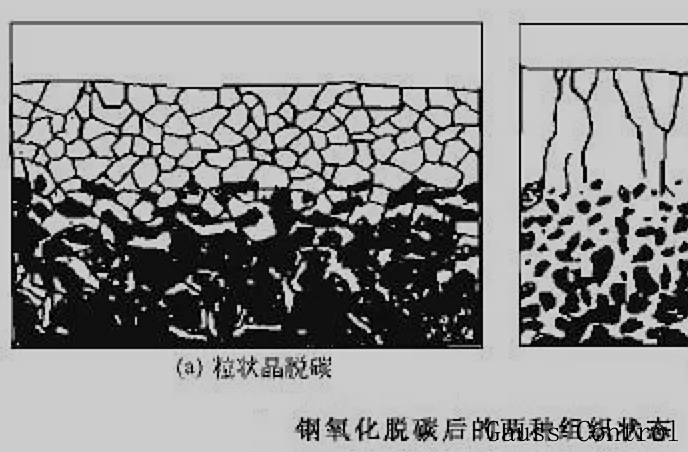

Steel typically undergoes thermal processing and heat treatment to achieve high strength and toughness or other specific properties. However, excessively high heating temperatures can lead to deterioration in the mechanical properties of steel, and even render the material unusable.
1. Overheating
Overheating during the heat treatment process is known to readily cause the austenite grains to coarsen, leading to a decline in the mechanical properties of components. Here's a breakdown of the types and consequences of overheating:
General Overheating:
This occurs when the heating temperature is too high or the holding time at high temperature is too long, causing the austenite grains to become coarse. Coarse austenite grains can result in reduced strength and toughness of the steel, an increase in the brittle transition temperature, and a higher tendency for deformation and cracking during quenching. Common causes of overheating include uncontrolled furnace temperature instruments or material mix-ups (often due to lack of process understanding). Overheated structures can be refined by annealing, normalizing, or multiple high-temperature tempering under normal conditions to re-austenitize and refine the grains.
Fracture Inheritance:
When steel with an overheated structure is reheated and quenched, although the austenite grains can be refined, coarse granular fractures may still appear. There are several theories regarding the cause of fracture inheritance. One common explanation is that excessive heating temperatures cause impurities like MnS to dissolve into the austenite and accumulate at the grain boundaries. During cooling, these inclusions precipitate along the grain boundaries, making the material susceptible to fracture along the coarse austenite grain boundaries when subjected to impact.
Inheritance of Coarse Microstructure:
When steel components with coarse martensite, bainite, or Widmanstätten structures are re-austenitized by slow heating to conventional quenching temperatures or even slightly lower, the austenite grains remain coarse. This phenomenon is known as microstructure inheritance. To eliminate microstructure inheritance, intermediate annealing or multiple high-temperature tempering treatments can be employed.
2. Overheating Phenomenon
Overheating occurs when the heating temperature is excessively high during heat treatment. This not only leads to the coarse grain growth of austenite but also causes localized oxidation or melting at the grain boundaries, resulting in weakened grain boundaries. Steel that has been overheated exhibits severely deteriorated properties and is prone to cracking during quenching.
The microstructure of overheated steel is irreversible, rendering the material unusable and leading to scrapping. Therefore, it is crucial to prevent overheating during heat treatment processes.
3. Decarburization and Oxidation Decarburization
Decarburization:
refers to the phenomenon where the carbon content in the surface layer of steel decreases during heating. This occurs due to the reaction between the surface carbon and oxidizing agents present in the surrounding medium or atmosphere, such as oxygen, hydrogen, carbon dioxide, and water vapor.
Steel that has undergone decarburization exhibits reduced surface hardness, fatigue strength, and wear resistance after quenching. Additionally, the formation of residual tensile stress on the surface makes it susceptible to surface network cracking.
Oxidation:
When steel is heated, the iron and alloying elements on the surface of the steel react with oxygen, carbon dioxide, water vapor, and other elements in the medium (or atmosphere) to form an oxide film. This phenomenon is called oxidation. High-temperature (generally above 570 degrees Celsius) oxidation of workpieces leads to deterioration of dimensional accuracy and surface brightness. Steel parts with poor hardenability and oxide film are prone to soft spots during quenching.
Measures to prevent oxidation and reduce decarburization include:
Surface Coating and Sealed Heating with Stainless Steel Foil: Applying a protective coating to the workpiece surface and then sealing it within a stainless-steel foil package before heating can effectively prevent both oxidation and decarburization.
Salt Bath Furnace Heating: Utilizing a salt bath furnace for heating provides an oxygen-free environment, minimizing oxidation and decarburization.
Protective Atmosphere Heating: Heating within a controlled atmosphere, such as purified inert gas or a furnace with controlled carbon potential, can prevent both oxidation and decarburization. This method ensures the atmosphere surrounding the workpiece does not react with it.
Flame Combustion Furnace (Reducing Furnace Atmosphere): Employing a flame combustion furnace with a controlled fuel-to-air ratio can create a reducing atmosphere within the furnace. This atmosphere, rich in carbon monoxide and hydrogen, helps prevent oxidation and decarburization of the workpiece.
4. Hydrogen Embrittlement
refers to the phenomenon where high-strength steel experiences a decrease in plasticity and toughness when heated in a hydrogen-rich atmosphere.
Workpieces affected by hydrogen embrittlement can be treated with dehydrogenation processes such as tempering or aging to eliminate the embrittlement. To prevent hydrogen embrittlement, heating can be carried out in a vacuum, low-hydrogen atmosphere, or inert atmosphere.


